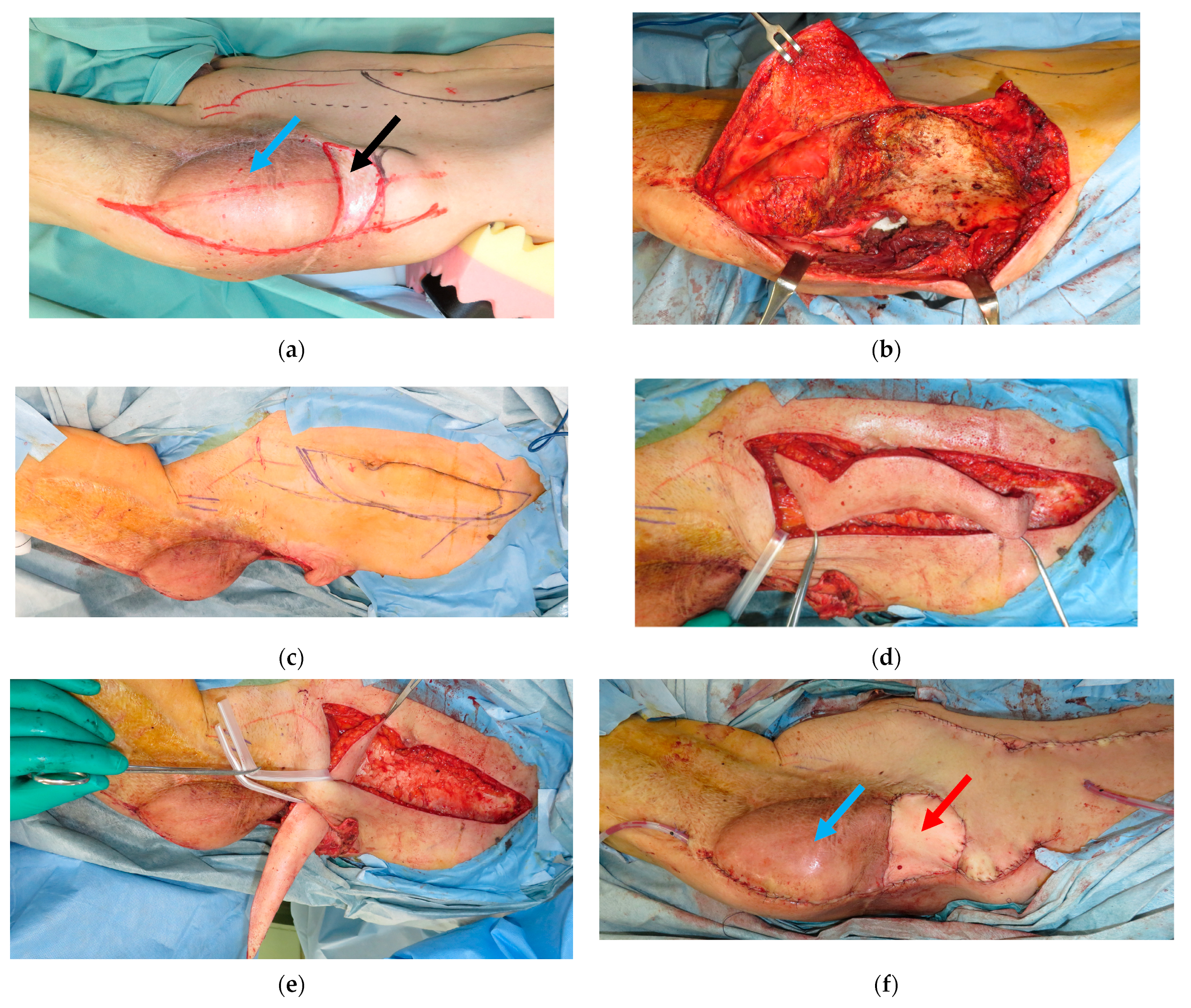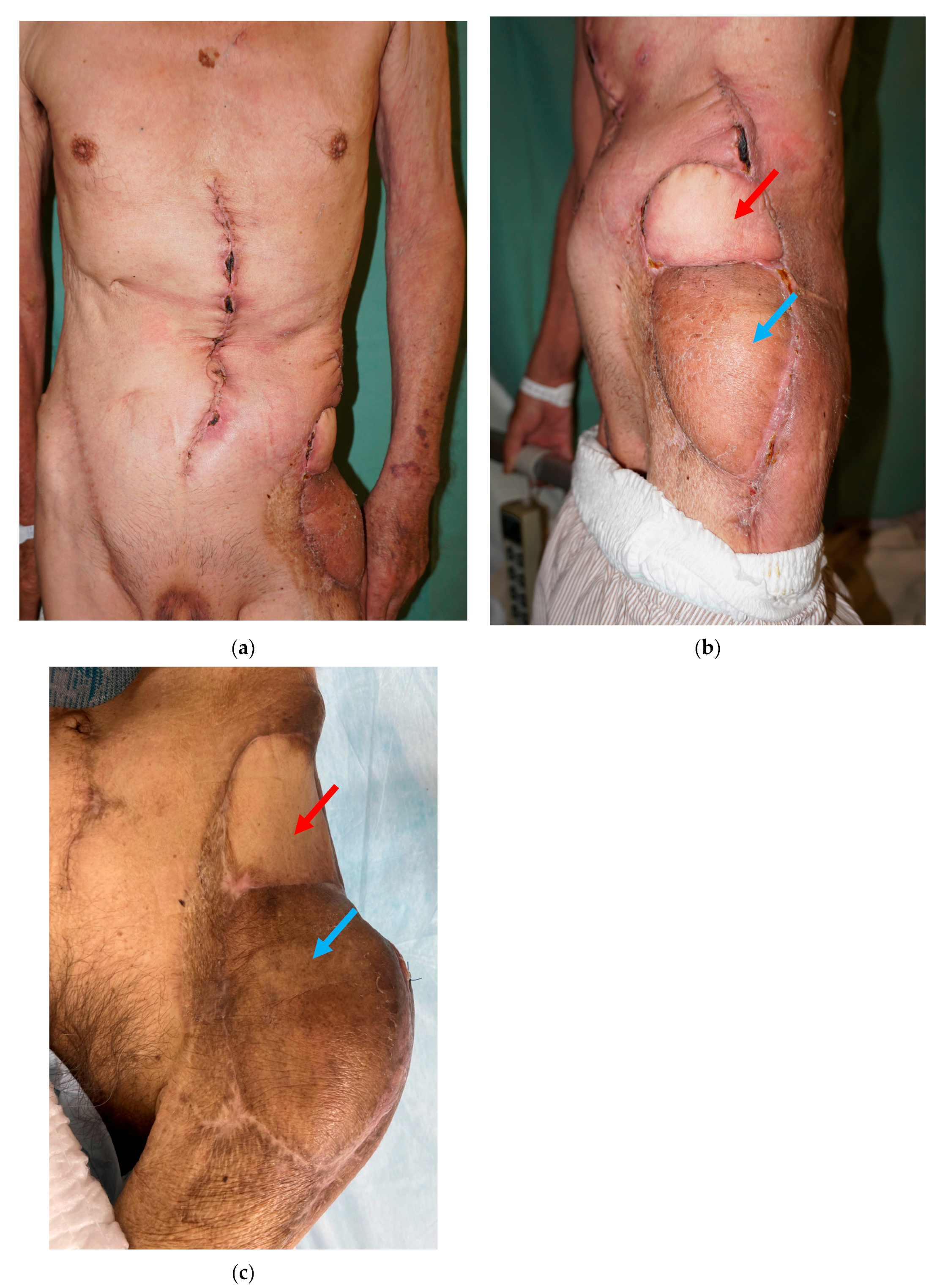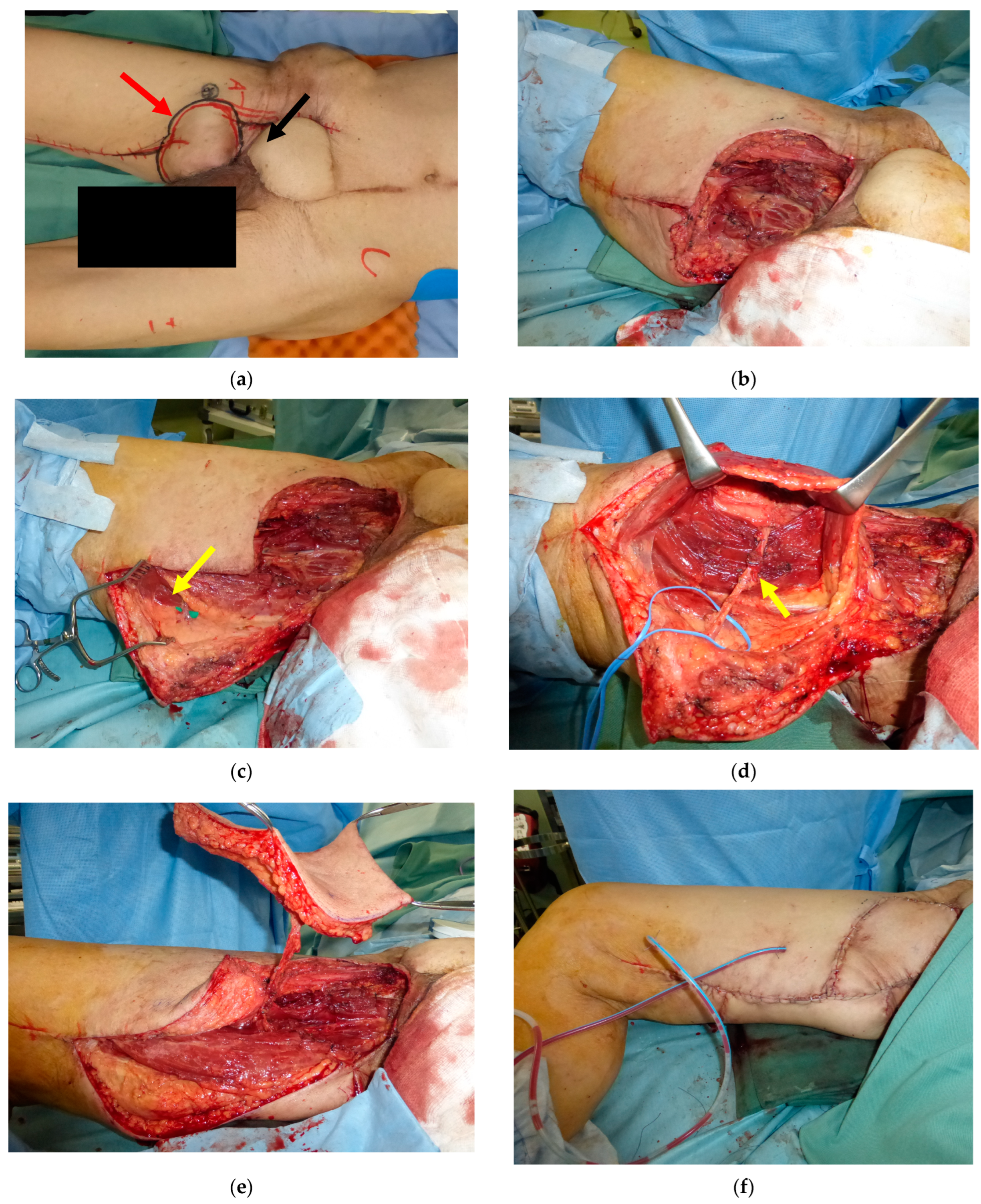Multiple Flap Transfer for Multiple Local Recurrence of Soft Tissue Sarcoma
Abstract
1. Introduction
2. Materials and Methods
Statistical Analysis
3. Results
3.1. Results
3.2. Case Reports
3.2.1. Case Seven
3.2.2. Case Eight
4. Discussion
5. Conclusions
Author Contributions
Funding
Institutional Review Board Statement
Informed Consent Statement
Data Availability Statement
Conflicts of Interest
References
- Clark, M.A.; Fisher, C.; Judson, I.; Thomas, J.M. Soft-Tissue Sarcomas in Adults. N. Engl. J. Med. 2005, 353, 701–711. [Google Scholar] [CrossRef] [PubMed]
- Cordeiro, P.G.; Neves, R.I.; Hidalgo, D.A. The Role of Free Tissue Transfer Following Oncologic Resection in the Lower Extremity. Ann. Plast. Surg. 1994, 33, 9–16. [Google Scholar] [CrossRef]
- López, J.F.; Hietanen, K.E.; Kaartinen, I.S.; Kääriäinen, M.T.; Pakarinen, T.-K.; Laitinen, M.; Kuokkanen, H. Primary flap reconstruction of tissue defects after sarcoma surgery enables curative treatment with acceptable functional results: A 7-year review. BMC Surg. 2015, 15, 71. [Google Scholar] [CrossRef] [PubMed]
- Krauss, S.; Goertz, O.; Pakosch-Nowak, D.; Daigeler, A.; Harati, K.; Lehnhardt, M.; Held, M.; Kolbenschlag, J. Microvascular tissue transfer after the resection of soft tissue sarcomas. J. Plast. Reconstr. Aesthetic Surg. 2021, 74, 995–1003. [Google Scholar] [CrossRef]
- Yoshimatsu, H.; Karakawa, R.; Fuse, Y.; Tanakura, K.; Yamamoto, T.; Okada, A.; Daniel, B.W.; Yano, T. Use of the superficial circumflex iliac artery perforator flap for reconstruction after sarcoma resection. J. Surg. Oncol. 2021, 123, 1067–1080. [Google Scholar] [CrossRef] [PubMed]
- Karakawa, R.; Yoshimatsu, H.; Tanakura, K.; Imai, T.; Yano, T.; Sawaizumi, M. Triple-lobe combined latissimus dorsi and scapular flap for reconstruction of a large defect after sarcoma resection. Microsurgery 2021, 41, 26–33. [Google Scholar] [CrossRef] [PubMed]
- Karakawa, R.; Yoshimatsu, H.; Maeda, E.; Shibata, T.; Tanakura, K.; Kuramoto, Y.; Miyashita, H.; Yano, T. Use of the Profunda Femoris Artery Perforator Flap for Reconstruction after Sarcoma Resection. Plast. Reconstr. Surg.-Glob. Open 2020, 8, e3289. [Google Scholar] [CrossRef]
- Karakawa, R.; Yoshimatsu, H.; Miyashita, H.; Kuramoto, Y.; Shibata, T.; Yano, T. Successful Balanced Gait after Reconstruction of the Weight-bearing Mid Plantar Region Using a Free Contralateral Medial Plantar Flap. Plast. Reconstr. Surg.-Glob. Open 2019, 7, e2456. [Google Scholar] [CrossRef] [PubMed]
- Fuse, Y.; Yoshimatsu, H.; Karakawa, R.; Yano, T. Pedicled anterolateral thigh flap transfer for the reconstruction of a large gluteal defect assisted by preoperative computed tomographic angiography and intraoperative indocyanine green angiography: A case report. Microsurgery 2021, 41, 777–781. [Google Scholar] [CrossRef]
- Ring, A.; Kirchhoff, P.; Goertz, O.; Behr, B.; Daigeler, A.; Lehnhardt, M.; Harati, K. Reconstruction of Soft-Tissue Defects at the Foot and Ankle after Oncological Resection. Front. Surg. 2016, 3, 15. [Google Scholar] [CrossRef]
- Sabolch, A.B.; Feng, M.; Griffith, K.; Rzasa, C.; Gadzala, L.; Feng, F.; Biermann, J.S.; Chugh, R.; Ray, M.; Ben-Josef, E. Risk Factors for Local Recurrence and Metastasis in Soft Tissue Sarcomas of the Extremity. Am. J. Clin. Oncol. 2012, 35, 151–157. [Google Scholar] [CrossRef] [PubMed]
- Cheney, M.D.; Giraud, C.; Goldberg, S.I.; Rosenthal, D.I.; Hornicek, F.J.; Choy, E.; Mullen, J.T.; Chen, Y.-L.; DeLaney, T.F. MRI surveillance following treatment of extremity soft tissue sarcoma. J. Surg. Oncol. 2014, 109, 593–596. [Google Scholar] [CrossRef] [PubMed]
- Labarre, D.; Aziza, R.; Filleron, T.; Delannes, M.; Delaunay, F.; Marques, B.; Ferron, G.; Chevreau, C. Detection of local recurrences of limb soft tissue sarcomas: Is magnetic resonance imaging (MRI) relevant? Eur. J. Radiol. 2009, 72, 50–53. [Google Scholar] [CrossRef] [PubMed]
- Rothermundt, C.; Whelan, J.S.; Dileo, P.; Strauss, S.J.; Coleman, J.; Briggs, T.W.; Haile, S.R.; Seddon, B.M. What is the role of routine follow-up for localised limb soft tissue sarcomas? A retrospective analysis of 174 patients. Br. J. Cancer 2014, 110, 2420–2426. [Google Scholar] [CrossRef] [PubMed]
- Watts, A.C.; Teoh, K.; Evans, T.; Beggs, I.; Robb, J.; Porter, D. MRI surveillance after resection for primary musculoskeletal sarcoma. J. Bone Jt. Surg. 2008, 90, 484–487. [Google Scholar] [CrossRef] [PubMed][Green Version]
- Ezuddin, N.S.; Pretell-Mazzini, J.; Yechieli, R.L.; Kerr, D.A.; Wilky, B.A.; Subhawong, T.K. Local recurrence of soft-tissue sarcoma: Issues in imaging surveillance strategy. Skelet. Radiol. 2018, 47, 1595–1606. [Google Scholar] [CrossRef] [PubMed]
- Potter, B.K.; Hwang, P.F.; Forsberg, J.A.; Hampton, C.B.; Graybill, J.C.; Peoples, G.E.; Stojadinovic, A. Impact of Margin Status and Local Recurrence on Soft-Tissue Sarcoma Outcomes. J. Bone Jt. Surg. 2013, 95, e151. [Google Scholar] [CrossRef]
- Stojadinovic, A.; Leung, D.H.Y.; Hoos, A.; Jaques, D.P.; Lewis, J.J.; Brennan, M.F. Analysis of the Prognostic Significance of Microscopic Margins in 2084 Localized Primary Adult Soft Tissue Sarcomas. Ann. Surg. 2002, 235, 424–434. [Google Scholar] [CrossRef]
- Sawamura, C.; Matsumoto, S.; Shimoji, T.; Tanizawa, T.; Ae, K. What Are Risk Factors for Local Recurrence of Deep High-grade Soft-tissue Sarcomas? Clin. Orthop. Relat. Res. 2012, 470, 700–705. [Google Scholar] [CrossRef]
- Smit, J.M.; Dimopoulou, A.; Liss, A.G.; Zeebregts, C.J.; Kildal, M.; Whitaker, I.S.; Magnusson, A.; Acosta, R. Preoperative CT angiography reduces surgery time in perforator flap reconstruction. J. Plast. Reconstr. Aesthetic Surg. 2009, 62, 1112–1117. [Google Scholar] [CrossRef]
- Feng, S.; Min, P.; Grassetti, L.; Lazzeri, D.; Sadigh, P.; Nicoli, F.; Torresetti, M.; Gao, W.; Di Benedetto, G.; Zhang, W.; et al. A Prospective Head-to-Head Comparison of Color Doppler Ultrasound and Computed Tomographic Angiography in the Preoperative Planning of Lower Extremity Perforator Flaps. Plast. Reconstr. Surg. 2016, 137, 335–347. [Google Scholar] [CrossRef]
- Barrantes, S.; Sadeghi, P.; Ojeda, A.L.; Porté, J.A.P.; Vinyals, J.M.V.; Barceló, L.H.; Lluis, E.C.; Compta, X.G.; Diaz, A.T.; Segú, J.O.B. Evaluation of virtual surgical planning and three-dimensional configurations for reconstruction of maxillary defects using the fibula free flap. Microsurgery 2022, 42, 749–756. [Google Scholar] [CrossRef] [PubMed]
- LoGiudice, J.A.; Haberman, K.B.; Sanger, J.R. The Anterolateral Thigh Flap for Groin and Lower Abdominal Defects: A better alternative to the rectus abdominis flap. Plast. Reconstr. Surg. 2014, 133, 162–168. [Google Scholar] [CrossRef] [PubMed]
- Miyamoto, S.; Fujiki, M.; Nakatani, F.; Kobayashi, E.; Sakisaka, M.; Sakuraba, M. Reconstruction of Complex Groin Defects After Sarcoma Resection. Ann. Plast. Surg. 2017, 78, 443–447. [Google Scholar] [CrossRef] [PubMed]
- Combs, P.D.; Sousa, J.D.; Louie, O.; Said, H.K.; Neligan, P.C.; Mathes, D.W. Comparison of Vertical and Oblique Rectus Abdominis Myocutaneous Flaps for Pelvic, Perineal, and Groin Reconstruction. Plast. Reconstr. Surg. 2014, 134, 315–323. [Google Scholar] [CrossRef] [PubMed]
- Parrett, B.M.; Winograd, J.M.; Garfein, E.S.; Lee, W.P.A.; Hornicek, F.J.; Austen, W.G., Jr. The Vertical and Extended Rectus Abdominis Myocutaneous Flap for Irradiated Thigh and Groin Defects. Plast. Reconstr. Surg. 2008, 122, 171–177. [Google Scholar] [CrossRef] [PubMed]
- Kiiski, J.; Kuokkanen, O.H.; Kääriäinen, M.; Kaartinen, I.S.; Pakarinen, T.-K.; Laitinen, M.K. Clinical results and quality of life after reconstruction following sacrectomy for primary bone malignancy. J. Plast. Reconstr. Aesthetic Surg. 2018, 71, 1730–1739. [Google Scholar] [CrossRef]
- Iida, T.; Isozaki, Y.; Numahata, T.; Okazaki, M. Sacral defect reconstruction using a sensate superior gluteal artery perforator flap based on the superior cluneal nerves: A report of two cases. Microsurgery 2021, 41, 468–472. [Google Scholar] [CrossRef]
- Miles, W.K.; Chang, D.W.; Kroll, S.S.; Miller, M.J.; Langstein, H.N.; Reece, G.P.; Evans, G.R.D.; Robb, G.L. Reconstruction of Large Sacral Defects following Total Sacrectomy. Plast. Reconstr. Surg. 2000, 105, 2387–2394. [Google Scholar] [CrossRef]
- Maricevich, M.; Maricevich, R.; Chim, H.; Moran, S.L.; Rose, P.S.; Mardini, S. Reconstruction following partial and total sacrectomy defects: An analysis of outcomes and complications. J. Plast. Reconstr. Aesthetic Surg. 2014, 67, 1257–1266. [Google Scholar] [CrossRef]
- Kim, J.E.; Pang, J.; Christensen, J.M.; Coon, D.; Zadnik, P.L.; Wolinsky, J.-P.; Gokaslan, Z.L.; Bydon, A.; Sciubba, D.M.; Witham, T.; et al. Soft-tissue reconstruction after total en bloc sacrectomy. J. Neurosurg. Spine 2015, 22, 571–581. [Google Scholar] [CrossRef] [PubMed]
- Garvey, P.B.; Rhines, L.D.; Feng, L.; Gu, X.; Butler, C.E. Reconstructive Strategies for Partial Sacrectomy Defects Based on Surgical Outcomes. Plast. Reconstr. Surg. 2011, 127, 190–199. [Google Scholar] [CrossRef] [PubMed]
- Huang, H.-Y.; Lal, P.; Qin, J.; Brennan, M.F.; Antonescu, C.R. Low-grade myxofibrosarcoma: A clinicopathologic analysis of 49 cases treated at a single institution with simultaneous assessment of the efficacy of 3-tier and 4-tier grading systems. Hum. Pathol. 2004, 35, 612–621. [Google Scholar] [CrossRef] [PubMed]
- Mentzel, T.; Calonje, E.; Wadden, C.; Camplejohn, R.S.; Beham, A.; Smith, M.A.; Fletcher, C.D. Myxofibrosarcoma. Myxofibrosarcoma. Clinicopathologic analysis of 75 cases with emphasis on the low-grade variant. Am. J. Surg. Pathol. 1996, 20, 391–405. [Google Scholar] [CrossRef] [PubMed]
- Weiss, S.W.; Enzinger, F.M. Malignant fibrous histiocytoma. An Analysis of 200 Cases. Cancer 1978, 41, 2250–2266. [Google Scholar] [CrossRef] [PubMed]
- Weiss, S.W.; Enzinger, F.M. Myxoid variant of malignant fibrous histiocytoma. Cancer 1977, 39, 1672–1685. [Google Scholar] [CrossRef] [PubMed]
- Merck, C.; Angervall, L.; Kindblom, L.G.; Odén, A. Myxofibrosarcoma. A malignant soft tissue tumor of fibroblastic-histiocytic origin. A clinicopathologic and prognostic study of 110 cases using multivariate analysis. Acta Pathol. Microbiol. Immunol. Scand. Suppl. 1983, 282, 1–40. [Google Scholar] [PubMed]
- Yoo, H.J.; Hong, S.H.; Kang, Y.; Choi, J.-Y.; Moon, K.C.; Kim, H.-S.; Han, I.; Yi, M.; Kang, H.S. MR imaging of myxofibrosarcoma and undifferentiated sarcoma with emphasis on tail sign; diagnostic and prognostic value. Eur. Radiol. 2014, 24, 1749–1757. [Google Scholar] [CrossRef]
- Song, B.; Lee, K.; Lee, C.; Moon, K.C. Prognostic significance of microscopic tumor extension in local recurrence of myxofibrosarcoma and undifferentiated pleomorphic sarcoma. Pathol. Int. 2018, 68, 509–516. [Google Scholar] [CrossRef]






| No | Age (Year) | Sex | BMI | Tabacco History | Defect Location | Total Number of Wide Resection | Total Number of Flap Reconstruction | Radiation Therapy | Follow-Up Period (Months) |
|---|---|---|---|---|---|---|---|---|---|
| 1 | 77 | male | 17.8 | - | lower extremity | 6 | 2 | + | 150 |
| 2 | 68 | female | 21.1 | - | buttock | 4 | 2 | + | 207 |
| 3 | 58 | female | 23.2 | - | lower extremity | 4 | 3 | − | 168 |
| 4 | 69 | male | 25.0 | - | buttock | 4 | 2 | + | 18 |
| 5 | 24 | male | 17.6 | - | back | 2 | 2 | − | 72 |
| 6 | 67 | male | 20.4 | + | back | 2 | 2 | − | 64 |
| 7 | 72 | male | 17.3 | + | groin | 3 | 3 | + | 67 |
| 8 | 70 | male | 26.6 | - | groin | 7 | 4 | + | 129 |
| Median | 68.5 | 20.7 | 4.0 | 2 | 101 | ||||
| IQR | 64.8–70.5 | 17.8–23.6 | 2.8–4.5 | 2–3 | 66–155 |
| No | Patient No | Age (yr) | Tumor Size (cm) | Defect Size (cm2) | Histology | Margin Positive | Flap Resection | Free/Pedicled | Flap | Flap Size (cm) | Complications |
|---|---|---|---|---|---|---|---|---|---|---|---|
| 1 | 1 | 77 | 20 × 13 × 12 | 95.0 | MFH | + | N/A | pedicle | GC | 15 × 11 | |
| 2 | 1 | 85 | 9 × 36 × 29 | 50.2 | MFH | + | + | pedicle | TFL | 10 × 8 | skin-graft necrosis |
| 3 | 2 | 68 | 35 × 25 × 10 | 63.4 | MFH | + | N/A | pedicle | GM | 10 × 9 | |
| 4 | 2 | 74 | 25 × 15 × 30 | 78.5 | MFH | − | - | pedicle | ALT | 18 × 10 | |
| 5 | 3 | 58 | 35 × 25 × 40 | 84.8 | MFH | − | N/A | pedicle | GC | 12 × 9 | |
| 6 | 3 | 61 | 12 × 8 × 13 | 28.3 | MFH | − | - | pedicle | ALT | 13 × 6 | |
| 7 | 3 | 63 | 22 × 28 × 30 | 62.8 | MFH | + | + | pedicle | GC | 10 × 8 | |
| 8 | 4 | 69 | 170 × 78 × 55 | 129.5 | OS | − | N/A | pedicle | RA | 17 × 11 | |
| 9 | 4 | 69 | 50 × 35 × 18 | 112.3 | OS | − | - | pedicle | GM | 15 × 11 | |
| 10 | 5 | 24 | 8 × 7 × 4 | 153.9 | myxoid LS | + | N/A | pedicle | LD | 29 × 14 | donor-site dehiscence |
| 11 | 5 | 25 | 95 × 55 × 28 | 400.4 | myxoid LS | − | + | free | ALT/TFL | 22 × 9, 30 × 9 | |
| 12 | 6 | 67 | 90 × 85 × 65 | 213.5 | UPS | − | N/A | pedicle | LD | 22 × 12 | take back, partial flap loss |
| 13 | 6 | 68 | 19 × 14 × 12 | 50.2 | UPS | − | - | pedicle | trapezius | 17 × 8 | seroma |
| 14 | 7 | 72 | 67 × 45 × 35 | 122.5 | UPS | − | N/A | pedicle | ALT | 24 × 12 | take back, total flap loss |
| 15 | 7 | 75 | 110 × 50 × 35 | 129.5 | UPS | + | + | free | PAP | 20 × 11 | donor-site dehiscence |
| 16 | 7 | 77 | 80 × 66 × 46 | 35.3 | UPS | + | - | pedicle | RA | 25.5 × 5 | |
| 17 | 8 | 70 | missing | 37.7 | MFH | − | N/A | pedicle | RA | 8 × 8 | infection |
| 18 | 8 | 75 | 50 × 22 × 10 | 31.4 | MFS | − | + | pedicle | sartorius | 16 × 4.5 | infection, lymphorrhea |
| 19 | 8 | 76 | N/A | 84.8 | N/A | N/A | + | pedicle | RA | 12 × 9 | |
| 20 | 8 | 80 | 100 × 75 × 65 | 84.8 | UPS | + | - | pedicle | PAP | 18 × 9 | |
| median range | 69.5 | 42.5 × 31.5 × 29.5 | 84.8 | 16.5 × 9 | |||||||
| IQR | 66–75.3 | 50.2–124 |
Disclaimer/Publisher’s Note: The statements, opinions and data contained in all publications are solely those of the individual author(s) and contributor(s) and not of MDPI and/or the editor(s). MDPI and/or the editor(s) disclaim responsibility for any injury to people or property resulting from any ideas, methods, instructions or products referred to in the content. |
© 2023 by the authors. Licensee MDPI, Basel, Switzerland. This article is an open access article distributed under the terms and conditions of the Creative Commons Attribution (CC BY) license (https://creativecommons.org/licenses/by/4.0/).
Share and Cite
Karakawa, R.; Yoshimatsu, H.; Fuse, Y.; Yano, T. Multiple Flap Transfer for Multiple Local Recurrence of Soft Tissue Sarcoma. Medicina 2023, 59, 1489. https://doi.org/10.3390/medicina59081489
Karakawa R, Yoshimatsu H, Fuse Y, Yano T. Multiple Flap Transfer for Multiple Local Recurrence of Soft Tissue Sarcoma. Medicina. 2023; 59(8):1489. https://doi.org/10.3390/medicina59081489
Chicago/Turabian StyleKarakawa, Ryo, Hidehiko Yoshimatsu, Yuma Fuse, and Tomoyuki Yano. 2023. "Multiple Flap Transfer for Multiple Local Recurrence of Soft Tissue Sarcoma" Medicina 59, no. 8: 1489. https://doi.org/10.3390/medicina59081489
APA StyleKarakawa, R., Yoshimatsu, H., Fuse, Y., & Yano, T. (2023). Multiple Flap Transfer for Multiple Local Recurrence of Soft Tissue Sarcoma. Medicina, 59(8), 1489. https://doi.org/10.3390/medicina59081489







